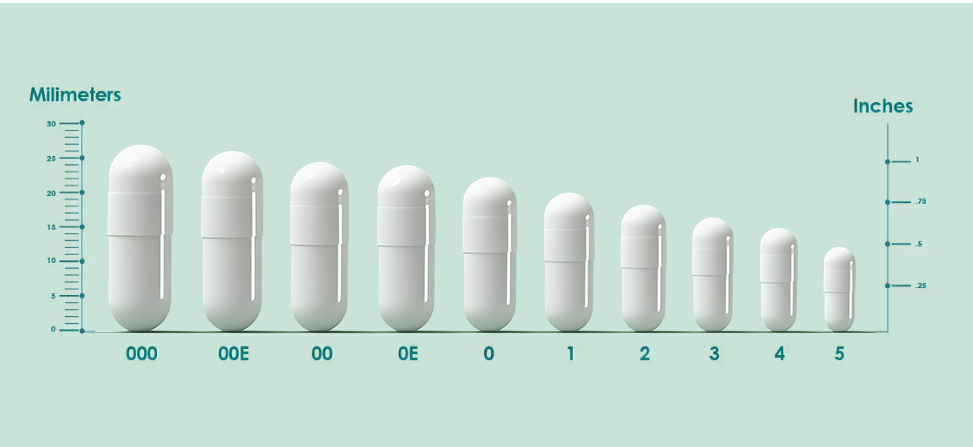
When selecting the right capsule sizes for your needs, understanding the available options is essential. Empty gel capsules and hypromellose (vegetarian) capsules come in standardized numerical sizes, ranging from the smallest capsule size (size 5) to the largest size of capsule (size 000). Each size corresponds to a specific fill capacity, ensuring versatility for different formulations.
Elongated variants, such as 00E and 0E, provide slightly more volume than standard capsules, making them ideal for certain applications. Whether you're filling capsules manually or using a capsule filling machine, choosing the correct size ensures accuracy and efficiency.
This guide will help you navigate the different capsule dimensions and capacities, allowing you to select the best fit for your requirements. Explore the capsule size chart below to make an informed decision for your supplements, medications, or other formulations.
Empty Capsule Size Chart
Choose The Right Sizes for Different Types of Capsules
Capsules are a popular way to take medicines, vitamins, and supplements. They come in different types, each with its benefits. Here’s a simple breakdown of the most common kinds:
1. Gelatin Capsules: These are the most common type. They are made from animal by-products, mainly gelatin. Gelatin capsules can be clear or colored and are easy to swallow. They dissolve quickly in the stomach, releasing the contents inside.
2. Vegetarian Capsules: Made from plant-based materials, these capsules are a good choice for vegetarians and vegans. Hypromellose capsules are a popular type of vegetarian capsule. They function similarly to gelatin capsules but are free from animal products.
3. Softgel Capsules: These capsules are smooth and soft, usually filled with liquid or oil. They are often used for fish oil or other liquid supplements. Softgels are easy to swallow and dissolve quickly.
4. Enteric-Coated Capsules: These capsules have a special coating that protects the contents from stomach acid. They dissolve in the intestines instead, which is useful for certain medications that need to avoid the stomach.
5. Delayed-Release Capsules: Similar to enteric-coated capsules, these are designed to release their contents slowly over time. This can help maintain a steady level of medication in the body.
| Capsule Type | 000 | 00 | 0 | 1 | 2 | 3 | 4 | 5 | Key Features |
|---|---|---|---|---|---|---|---|---|---|
| Gelatin Capsules | ✔ | ✔ | ✔ | ✔ | ✔ | ✔ | ✔ | ✔ | Animal-derived, fast-dissolving, clear/colored options |
| HPMC (Hypromellose) | ✔ | ✔ | ✔ | ✔ | ✔ | ✔ | ✔ | ✔ | Plant-based, vegan-friendly, similar to gelatin |
| Vegetable Capsules | ✘ | ✔ | ✔ | ✔ | ✘ | ✘ | ✘ | ✘ | Limited size options, plant-based |
| Softgel Capsules | ✔ | ✔ | ✔ | ✔ | ✘ | ✘ | ✘ | ✘ | Liquid/oil-filled, smooth, easy to swallow |
| Enteric-Coated | ✔ | ✔ | ✔ | ✔ | ✔ | ✔ | ✔ | ✔ | Acid-resistant, dissolves in intestines |
| Delayed-Release | ✔ | ✔ | ✔ | ✔ | ✔ | ✔ | ✔ | ✔ | Slow dissolution, extended release |
Empty Capsules Scale Chart
Capsules are classified by sizes that range from 5 (the smallest) to 000 (the largest). In this system, a higher number indicates a smaller capsule.






Leave a Reply